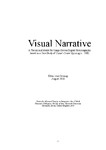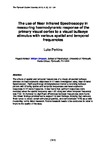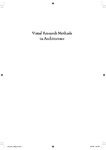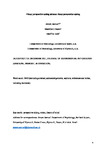Visual Narrative: A Theory and Model for Image-Driven Digital Historiography based on a Case Study of China’s Boxer Uprising (c. 1900)
| dc.contributor.supervisor | Ascott, Roy | |
| dc.contributor.author | Sebring, Ellen Irene | |
| dc.contributor.other | Faculty of Arts, Humanities and Business | en_US |
| dc.date.accessioned | 2016-10-18T10:39:57Z | |
| dc.date.available | 2016-10-18T10:39:57Z | |
| dc.date.issued | 2016 | |
| dc.identifier | 10266815 | en_US |
| dc.identifier.uri | http://hdl.handle.net/10026.1/6566 | |
| dc.description.abstract |
Digitization that has enabled instant access to vast numbers of archival, historical images, demands a new paradigm for the use of visual imagery in historical research. This thesis proposes a new form of historiography in the digital medium, an image-based narrative mode for authoring and reading history. I propose a digital model for conveying history through the visual record, as an alternative to the printed book. Unlike the quantitative “big data” approach to digital humanities, this research explores visuality itself. In a practice-led approach, the research addresses both aspects of historiography: (1) a method of historical representation; and (2) original historical work on a selected topic. The testbed for historiographic and narrative experiments which led to the model was my case study on the Boxer Uprising in China, c. 1900. While many written histories of the Boxer Uprising exist, I collected a large portion of its extensive visual record for the first time. Sources from around the world, in a variety of media, were assembled into a digital data set that reveals previously unexplored historical themes. A series of visual narratives built in the case study culminated in a proposed “Visual Narrative Field” model. In this model, meaning emerges in the patterns observed between images within a complex visual field. The model vertically integrates three narrative approaches in order to support alternating cognitive modes used to read texts and perceive images. Linear concentration is blended with the non-linear exploration of interactive forms. The model provides historians with a much-needed tool for authoring narrative through relationships between images in a scalable approach. Due to digitization, visual databases are easily assembled, and images are as easily reproduced as written text. The Visual Narrative Field model takes advantage of the characteristics of the newly-digitized visual record, providing a means of authoring visual narrative that can be comprehended without the use of extensive written text. The model thus creates an unprecedented image-based method for performing and presenting historical research. | en_US |
| dc.language.iso | en | en_US |
| dc.publisher | Plymouth University | en_US |
| dc.subject | Digital History | en_US |
| dc.subject | Visual History | |
| dc.subject | Historical images | |
| dc.subject | Visual Data | |
| dc.subject | Data Visualization | |
| dc.subject | Boxer Uprising | |
| dc.subject | MIT Visualizing Cultures | |
| dc.subject | Historiography | |
| dc.subject | China, turn of the century | |
| dc.subject | Digital Humanities | |
| dc.subject | Image-driven Scholarship | |
| dc.subject.classification | PhD | en_US |
| dc.title | Visual Narrative: A Theory and Model for Image-Driven Digital Historiography based on a Case Study of China’s Boxer Uprising (c. 1900) | en_US |
| dc.type | Thesis | |
| plymouth.version | publishable | en_US |
| dc.identifier.doi | http://dx.doi.org/10.24382/3534 | |
| dc.rights.embargoperiod | No embargo | en_US |
| rioxxterms.funder | Not available | en_US |
| rioxxterms.identifier.project | Not available | en_US |
Files in this item
This item appears in the following Collection(s)
-
01 Research Theses Main Collection
Research Theses Main





